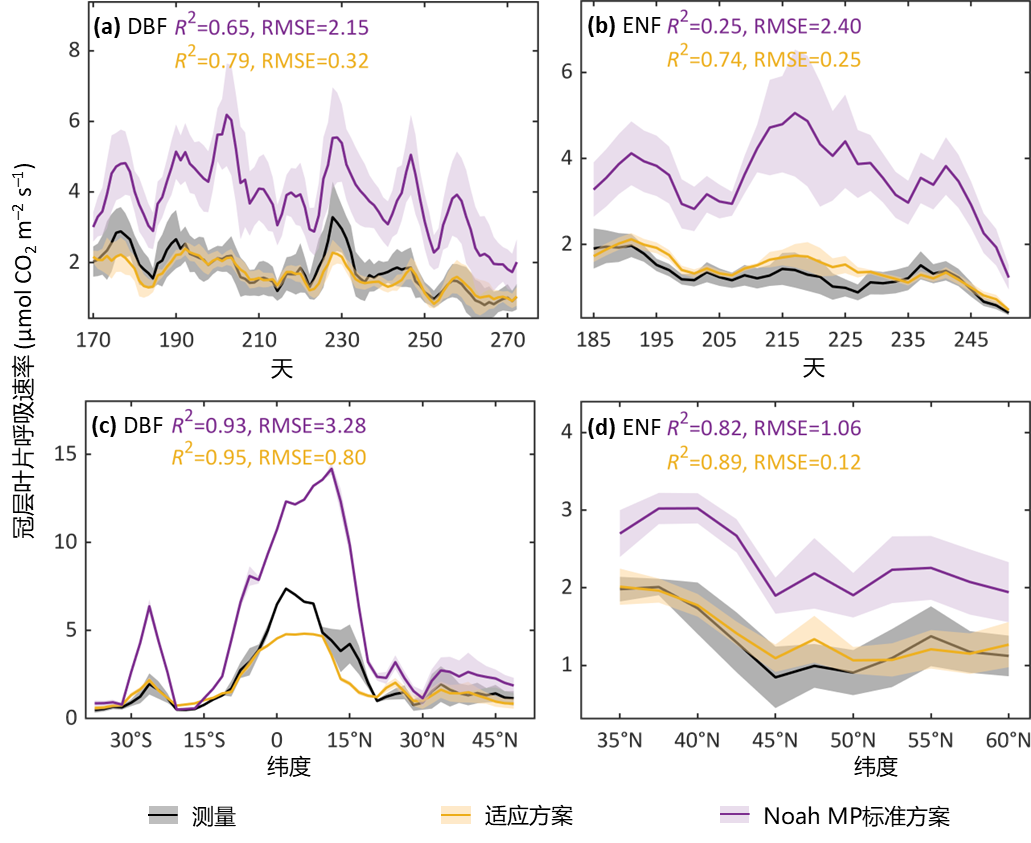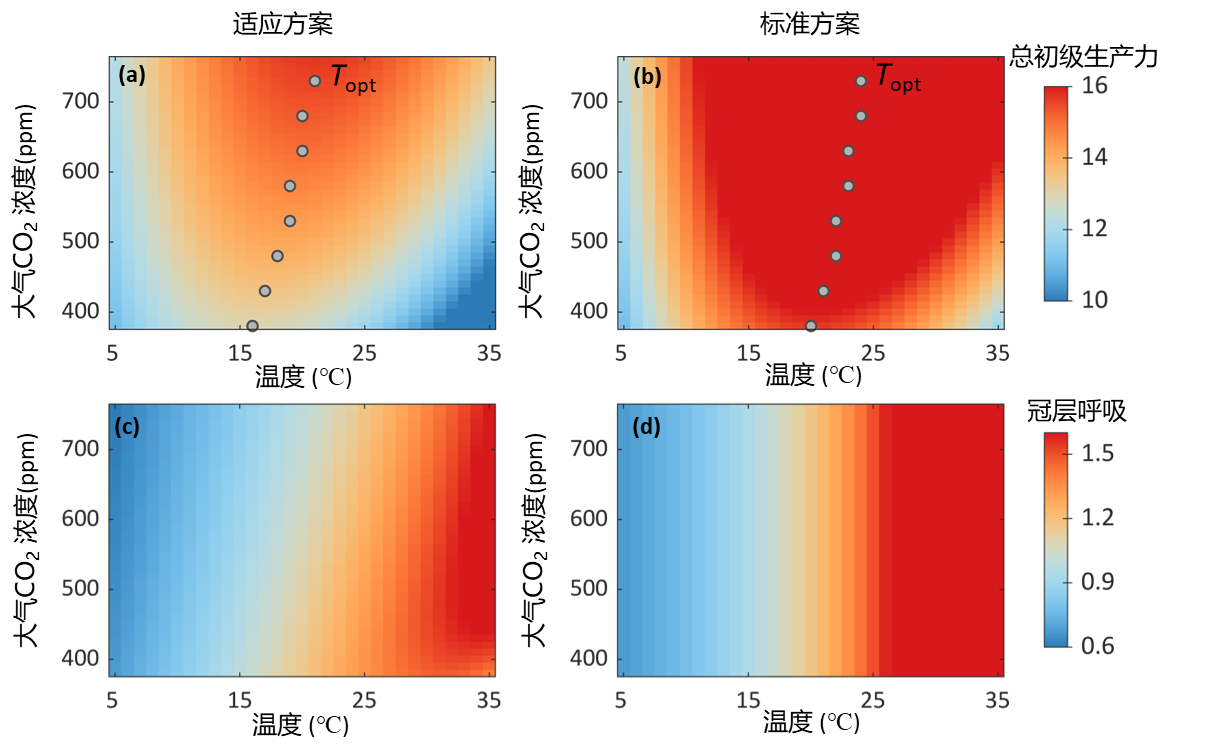Understanding and predicting the adaptive responses of plants to global changes and their impacts on the carbon cycle of terrestrial ecosystems have always been a central topic in global change ecology. Earth system models are important tools for quantitative research on this topic. Traditional land surface components of Earth system models typically assume constant functional traits, such as maximum carboxylation capacity 1(Vcmax,25) and basal leaf respiration rate (R25), for the same vegetation type or plant functional type (PFT) when simulating canopy carbon fluxes. However, substantial observational evidence indicates that plants exhibit adaptive responses to long-term environmental changes through physiological adjustments. For instance, in warm environments, plants down-regulate Vcmax,25 and R25, to reduce carbon consumption for maintaining vital activities. Traditional models neglect these dynamic regulatory processes, leading to significant uncertainties in predicting carbon budgets of terrestrial ecosystems under climate change scenarios.
To address this problem, the research group led by Associate Professor Wang Han from the Department of Earth System Science (DESS) at Tsinghua University developed a concise and universal canopy photosynthesis-respiration flux simulation scheme based on the optimality theory of photosynthetic and respiratory evolution. This scheme, incorporating an Ecosystem Evolutionary Optimization (EEO) approach to represent the universal acclimation of photosynthesis and leaf respiration to multiple environmental factors without PFT-specific parameterization, was integrated into the traditional land surface model Noah-MP. The results demonstrated that the improved Noah-MP model, with reduced parameters and eliminated need for PFT allocation, enhanced model universality and computational efficiency, while significantly improving the simulation accuracy of short-term and long-term canopy carbon fluxes. The research findings were published in the Journal of Advances in Modeling Earth Systems, offering a more reliable tool for assessing and predicting terrestrial carbon sink dynamics.
The new scheme abandoned the concept of PFTs in the traditional model, and introduced the universal ecological evolution optimality theory as the constraint condition for the changes of plant photosynthetic and respiratory function in the model, so as to realize the dynamic prediction of the static parameters of PFTs. By employing a 15-day sliding time window to dynamically calculate the mean values of environmental factors (e.g., temperature, radiation, soil moisture) and predicting the optimal Vcmax,25 and R25 values adapted to these conditions based on the EEO theory, the scheme achieved a refined characterization of seasonal dynamics in photosynthetic and respiratory traits with only three universal parameters. This represents a substantial simplification compared to the traditional Noah-MP scheme, which relies on static parameters for 12 PFTs.
Validation using data from 168 global flux tower sites and 53 trait observation sites revealed:
1.Trait Simulation: The new scheme explained 62% and 73% of the seasonal variations in Vcmax,25 and R25, respectively, whereas the traditional scheme overlooked these dynamics (Fig. 1).
2.Carbon Flux Simulation: The new scheme reduced the root mean square error (RMSE) of gross primary productivity (GPP) simulation at the half-hourly scale from 3.6µmolCO₂m⁻⟡ s⁻¹ to 2.4µmol CO₂m⁻⟡s⁻¹, decreased the underestimation of monthly GPP from 10% to 2%, and reduced the simulation deviation of canopy respiration from 200% to 8% (Figs. 2 and 3).
3.Climate Response: Influenced by plant physiological and ecological adjustments, the warming-induced enhancement of GPP was 60% lower in the new scheme compared to traditional models. Additionally, physiological adaptation to warming led to a c. 80% reduction in the increase of canopy respiration.
Elevated atmospheric CO₂ concentrations further suppressed carbon release from canopy respiration by reducing R25.
These findings indicate that plant physiological adaptations enhance the climate resilience and carbon sequestration capacity of terrestrial ecosystems under global warming. Traditional models, which neglect these processes, may underestimate terrestrial carbon sink capacity under future climate scenarios and overestimate the climate-carbon positive feedback effect of the Earth system.

Fig. 1 Evaluations of photosynthetic and respiratory traits by the two schemes

Fig. 2 Evaluations of GPP by two schemes

Fig. 3 Evaluations of Rcanopy at the trait‐measurement sites

Fig. 4 Responses of GPP and Rcanopy to warming and atmospheric CO2 concentration

This study enhances the ability of land surface models to depict physiological mechanisms and provides a robust scientific tool for global carbon budget assessment and climate policy formulation. Ren Yanghang, a Ph.D. student from Tsinghua DESS, served as the first author, with Associate Professor Wang Han as the corresponding author. Co-authors include Professor Yang Kun and researchers from the University of Reading, Imperial College London, Southwest University, the University of Minnesota, the University of Michigan, and Western Sydney University. The research was supported by the National Natural Science Foundation of China (Grant No. 72140005).
Full-text link: https://agupubs.onlinelibrary.wiley.com/doi/full/10.1029/2024MS004599
Written by Ren Yanghang
Edited by Wang Han
Reviewed by Zhang Qiang